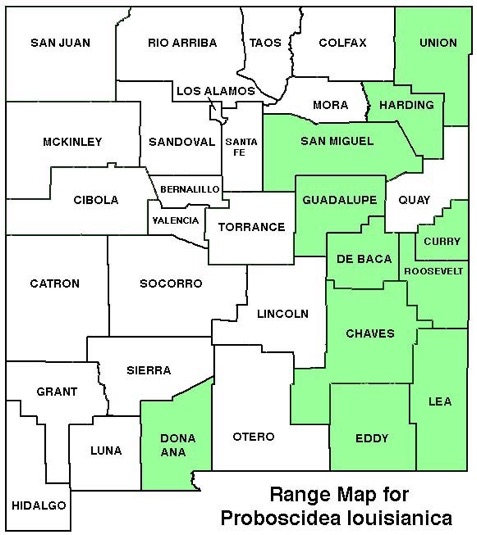WILDFLOWERS OF NEW MEXICO

Low spreading and 1–3 feet tall and 4–6-feet wide, this hairy plant is one of four Devil’s Claw species in NM that has fleshy stems, bizarre forked seedpods, and is densely covered with large, sticky leaves. Note the pale pink to white flowers with purple spots on the upper lobe. It sometimes escapes landscape cultivation and occurs outside its historic range. Proboscidea was formerly classified in the Sesame family, Pedaliaceae.
FLOWER: June–September. Clusters of 8–20 unusual, musky-smelling flowers bloom a few at a time on hairy stems to 7 3/4-inches long above the leaves. United petals form a funnel-shaped tube 1 3/8–2 1/8 inches long and wide (33–55 mm), with 5 petal-like lobes. The pinkish-white flowers have brown to purple spots inside the throat and yellow lines, nectar guides, on the bottom lobe. The bizarre fruit ripens as a 3/4-inches long (7 cm) okra-like pod, about 3/4-inch thick (2 cm), and tapering to a hooked point. When dry, the end of the pod splits open with two woody, curved spines with sharp hooks that snare onto animals and disperse the seeds.
LEAVES: Opposite. Blades heart- to kidney-shaped reaching 12 inches long and wide (30 cm); margins entire. Glandular hairs make the leaves feel sticky or clammy.
HABITAT: Dry, sunny, hot sandy soils of fields, roadsides, disturbed areas; prairies and plains of eastern NM.
RANGE: CO, NM, OK, TX; naturalized throughout most of USA.
SIMILAR SPECIES: 4 species of devil’s claw in NM. P. parviflora with 1-inch wide, pinkish flowers and the upper lobe had a solid purple blotch with no spots; P. sabulosa, rare in sand dunes of se counties, has a 3/8-inch (1 cm) wide flower; P. althaeifolia (see photo), in southern 1/2 NM, has yellow flowers.
NM COUNTIES: Eastern NM plains in low- to mid-elevation, dry habitats: Chaves, Curry, De Baca, Dona Ana, Eddy, Guadalupe, Harding, Lea, Roosevelt, San Miguel, Union.









UNICORN PLANT, DEVIL’S CLAW
PROBOSCIDEA LOUISIANICA
Unicorn Plant Family, Martyniaceae
Annual herb









THE CONTENTS OF THIS WEBSITE ARE COPYRIGHTED AND CANNOT BE USED
WITHOUT PERMISSION OF GEORGE OXFORD MILLER


























• The upper lobe has internal purple spots, a distinguishing feature of the species (top arrow).
• Yellow nectar lines on the bottom lobe guide pollinators into the inflated throat of the flower (bottom arrow).




























SIMILAR SPECIES
A yellow Devil’s Claw, Desert Unicorn Plant, P. althaeifolia, occurs in southern NM.

The hooked tip of the fresh fruit (left) dries and splits open into two sharp claws (right) that hook onto an animal to disperse the seeds.








EMAIL ME
















